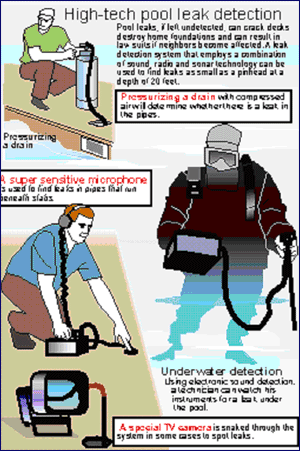Even minor swimming pool leak can cause substantial damage and result in huge water bills and it is estimated that one pool in every 20 has a leak.
Just how serious can a leak become? A pinhole-sized leak in a pool plumbing system with 40-pound pressure (psi) will lose approximately 970 gallons of water in a 24-hour period.
This comes to about 30,000 gallons a month or 360,000 gallons per year. That’s enough to drain and refill the average residential swimming pool more than a dozen times.
In addition to an astronomical water bill, there are other warning signs of hidden leaks in pools and spas. Among them are a loss of one-eighth inch or more of water in a 24 hour period, algae formation too soon after chemical treatment, loose or falling tiles, pool deck cracks, gaps and cracks in the pool shell, a settling of the whole pool or spa structure into the ground or constantly damp soil surrounding the pool and/or under the house.

Another leak indicator might be a letter from your neighbor’s attorney advising you that your leaking pool is destroying their foundation.
Many people believe that water loss in a pool or spa is due to evaporation instead of a leak. If you are among these believers, here’s a neat trick that will help solve the mystery. Place a bucket on the top step of the pool and fill it with water to the pool’s water level. After a day, if the water level in the pool is lower than the bucket, there probably is a leak in the pool structure or plumbing system.
To further detect whether the cause is the structure or the plumbing system, measure the water loss with the pump running for 24 hours and again with the pump off. If more water is lost when the pump is running, the plumbing is probably the cause.
Thanks to state-of-the-art technology, most pool or spa leaks can be found and repaired without major disruption or the need to take out a second mortgage. Sophisticated detection equipment along with a qualified technician can find even the smallest leak – one the size of a pinhead.
The latest in high-tech leak detection equipment uses a special television camera that is snaked through plumbing pipes to spot leaks. The camera delivers a clear picture on a video screen showing the problem while a transmitter located in the camera head pinpoints its location. Although this system is used primarily for sewer and drain leak detection, it is also used to detect leaks in swimming pool pipes.
Another modern means of detecting leaks below concrete pool decking or in pool walls is a supersensitive microphone. By injecting air or inert gas into a pipe, then listening electronically for sounds of air or gas escaping, the technician can precisely locate the leak. Once the location has been determined, the repair can be made with minimal damage, often in an area as small or smaller than one square foot.
When a television camera or sound won’t do the trick, air can save the day. With this method, compressed air is used to pressurize a pipe. The air displaces the water in the pipe until it reaches the leak, at which point bubbles escape from the hole to reveal the problem area. Or, where a pipe fails to maintain a constant air pressure, a leak exists.
A not-so-new method of detecting cracks in a pool structure is the use of dye. The key to this method is to monitor the flow of the dye in the water. Once a leak has been found in a pool wall it can be repaired with an epoxy or high-pressure injection system that will fill even microscopic fissures along the entire length of a crack. Many of these techniques can be performed even while the pool is full of water-another water saver.
You should expect to pay about $175 to $250 for high-tech leak detection, depending upon the location and complexity of the problem. Repairs are extra.
- What to Do if Your House Smells Like Gas but There’s No Leak - February 6, 2023
- Why Is There a Burning Smell Coming From My Vents? - August 16, 2022
- How to Remove the Musty Smell From Your Air Conditioner - August 16, 2022

